But 12-year-old Oliver Gorman of Greater Manchester and “a sweet boy, a lovely family boy,” according to his mom, was just as dead as if he had intended to take the fatal dose.
Oliver, who had been struggling with verbal bullying and feelings of being “low,” was a victim of a dangerous TikTok challenge known as “chroming,” where children inhale toxic fumes from household items for a quick high.
“As a parent, I just feel numb and upset.”
The inquest hearing into his death put yet another human face on the growing roster of young lives lost to inhalants—deodorant sprays, nail polish and nail polish removers, gasoline, correction fluids, spray paints, felt-tip markers, glues, cleaning fluids and other household items.
Five such cans were found in Oliver’s bedroom.
“The covert nature of these items means that parents and teachers are less likely to detect the behavior, significantly increasing the risk of repeated usage and addiction among adolescents,” said Keerthi Krishna, research assistant at Cohen Children’s Medical Center.

They’re not only cheaper than illegal drugs, but far more accessible—just a few paces away in the kitchen or cleaning cabinet.
Even a single inhalation can cause “sudden sniffing death syndrome.” Other “lesser” side effects include permanent brain, heart and lung damage, slurred speech, hallucinations, dizziness, heart attacks, suffocation and seizures.
So the culprit isn’t a figure in the shadows peddling illegal poison that killed 12-year-old Cesar Watson-King, whose mother found him on the kitchen floor, or 13-year-old Esra Haynes, who lingered for eight days after sustaining irreparable brain damage. It’s not some monolithic, far-away drug cartel that ended the life of 14-year-old Sara Mescall after taking the challenge, or 11-year-old Tommie-Lee Gracie Billington, who died at a friend’s sleepover.
No, the Pied Piper luring our children to their doom is TikTok.
A 2024 American Academy of Pediatrics study analyzing 109 TikTok chroming videos found that markers were the most common item (31 percent), followed by air dusters (17 percent), nail polish (12 percent), and paint thinner, gasoline and spray deodorants (11 percent). Thirty-nine percent of creators were minors and 52 percent referenced repeated use or addiction.
“It is really quite frightening what is put out by social media, which affects the young minds of people like Oliver. There needs to be more awareness,” assistant coroner Andrew Bridgman said at the hearing on Oliver’s death. “A major concern is that TikTok disseminates these challenges without any regard to the well-being of those who subscribe to it.”
“As a parent, I just feel numb and upset,” said Clare Gillespie, Oliver’s mom. “Don’t buy your children these solvents and don’t have them in your home.”
And then came the sentence that should stop every parent cold: “I never thought this could happen to my child.”






















